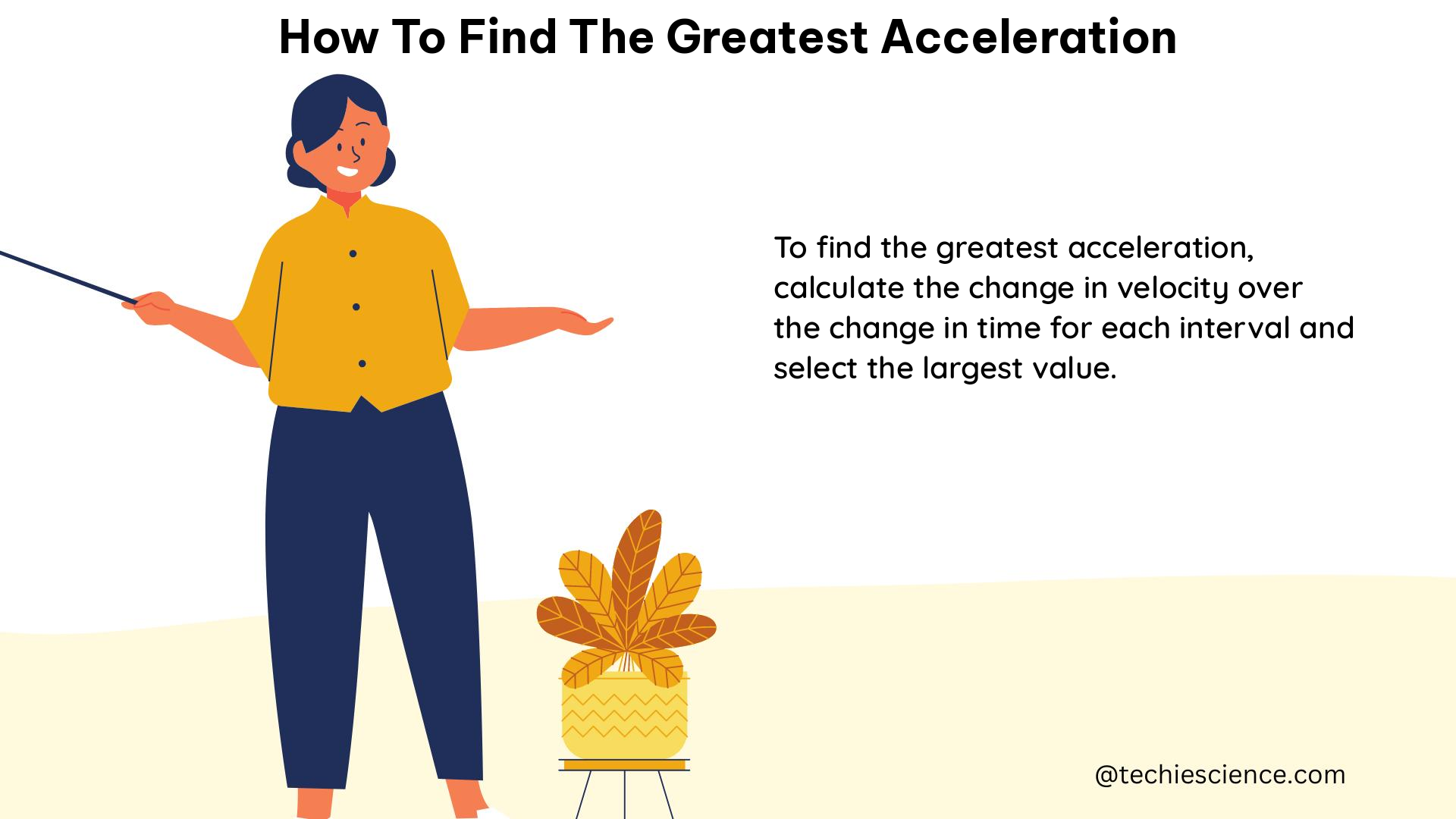Summary
Acceleration is a fundamental concept in physics, representing the rate of change in velocity over time. To find the greatest acceleration, one must analyze the acceleration-time graph and identify the maximum point, where the slope of the tangent line is zero, and the second derivative is negative. This guide delves into the technical details, formulas, examples, and problem-solving strategies to help physics students and enthusiasts master the art of finding the greatest acceleration.
Understanding Acceleration

Acceleration, denoted by the symbol ‘a’, is a vector quantity that describes the change in velocity over time. It is mathematically represented by the equation:
a = Δv/Δt
Where:
– a is the acceleration (in m/s²)
– Δv is the change in velocity (in m/s)
– Δt is the change in time (in s)
Acceleration can be positive or negative, indicating an increase or decrease in velocity, respectively. It is a crucial factor in the analysis of motion and the behavior of physical systems.
Identifying the Greatest Acceleration
To find the greatest acceleration, you need to analyze the acceleration-time graph of the motion. The maximum point on this graph represents the greatest acceleration.
Step 1: Construct the Acceleration-Time Graph
The first step is to plot the acceleration-time graph for the given motion. This graph will show the variation of acceleration over time.
Step 2: Locate the Maximum Point
The maximum point on the acceleration-time graph is the point where the acceleration is greatest. This point is characterized by the following properties:
-
Slope of the Tangent Line: At the maximum point, the slope of the tangent line to the acceleration-time curve is zero. This means that the rate of change of acceleration is zero at this point.
-
Second Derivative: The second derivative of the acceleration-time function is negative at the maximum point. This confirms that the point is a true maximum.
Step 3: Determine the Greatest Acceleration
The value of the acceleration at the maximum point is the greatest acceleration. This can be calculated by substituting the time value at the maximum point into the acceleration equation:
a_max = Δv/Δt
where a_max is the greatest acceleration, Δv is the change in velocity at the maximum point, and Δt is the change in time at the maximum point.
Formulas and Equations
To find the greatest acceleration, you can use the following formulas and equations:
-
Acceleration Equation:
a = Δv/Δt -
Velocity-Time Relationship:
v = u + at
wherevis the final velocity,uis the initial velocity,ais the acceleration, andtis the time. -
Displacement-Time Relationship:
s = ut + (1/2)at^2
wheresis the displacement,uis the initial velocity,ais the acceleration, andtis the time. -
Second Derivative Test for Maximum/Minimum:
If the first derivative of a functionf(x)is zero at a pointx = a, and the second derivativef''(a)is negative, thenf(a)is a local maximum.
Examples and Problem-Solving
Example 1: Finding the Greatest Acceleration in a Projectile Motion
A projectile is launched with an initial velocity of 50 m/s at an angle of 60° above the horizontal. Assuming no air resistance, find the greatest acceleration experienced by the projectile.
Given:
– Initial velocity, u = 50 m/s
– Angle of launch, θ = 60°
Step 1: Calculate the initial vertical and horizontal velocities.
Vertical velocity, v_y = u sin(θ) = 50 × sin(60°) = 43.3 m/s
Horizontal velocity, v_x = u cos(θ) = 50 × cos(60°) = 25 m/s
Step 2: Find the time when the vertical velocity becomes zero (maximum height).
Using the equation v_y = u_y + at, we can solve for the time t when v_y = 0:
0 = 43.3 - 9.8t
t = 4.42 s
Step 3: Calculate the greatest acceleration.
The greatest acceleration occurs at the maximum height, where the vertical velocity is zero.
The vertical acceleration is constant and equal to the acceleration due to gravity, g = -9.8 m/s².
Therefore, the greatest acceleration is a_max = -9.8 m/s².
Example 2: Finding the Greatest Acceleration in a Circular Motion
A car is moving in a circular path with a constant speed of 72 km/h and a radius of 50 m. Find the greatest acceleration experienced by the car.
Given:
– Speed, v = 72 km/h = 20 m/s
– Radius, r = 50 m
Step 1: Calculate the centripetal acceleration.
Centripetal acceleration, a_c = v²/r = (20 m/s)²/50 m = 8 m/s²
Step 2: Determine the greatest acceleration.
In circular motion, the greatest acceleration is the centripetal acceleration, a_max = a_c = 8 m/s².
Problem-Solving Strategies
- Identify the type of motion (linear, projectile, circular, etc.) and the given information.
- Construct the acceleration-time graph for the motion.
- Locate the maximum point on the acceleration-time graph by analyzing the slope of the tangent line and the second derivative.
- Substitute the time value at the maximum point into the acceleration equation to find the greatest acceleration.
- Verify the result using the second derivative test for maximum/minimum.
Conclusion
Finding the greatest acceleration is a crucial skill in physics, as it helps understand the behavior of physical systems and predict their motion. By following the steps outlined in this guide, you can effectively identify the maximum point on the acceleration-time graph and determine the greatest acceleration. Remember to practice solving various problems and applying the concepts to solidify your understanding of this topic.
References
- https://www.quantified.ai/blog/best-sales-acceleration-tools-to-drive-insights-and-win-more-sales/
- https://quizlet.com/556898590/physics-flash-cards/
- https://www.youtube.com/watch?v=5P1O6tBiTlQ
- https://www.sciencedirect.com/topics/engineering/measurable-quantity
- https://www.khanacademy.org/science/physics/one-dimensional-motion/acceleration-tutorial/v/acceleration

The lambdageeks.com Core SME Team is a group of experienced subject matter experts from diverse scientific and technical fields including Physics, Chemistry, Technology,Electronics & Electrical Engineering, Automotive, Mechanical Engineering. Our team collaborates to create high-quality, well-researched articles on a wide range of science and technology topics for the lambdageeks.com website.
All Our Senior SME are having more than 7 Years of experience in the respective fields . They are either Working Industry Professionals or assocaited With different Universities. Refer Our Authors Page to get to know About our Core SMEs.